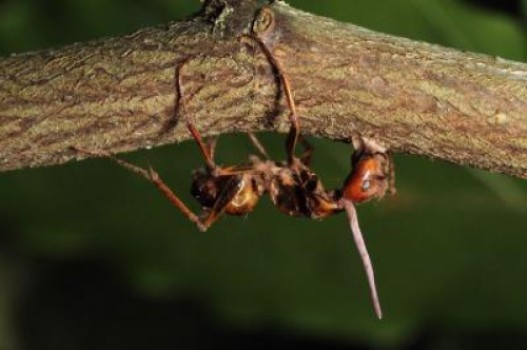We're open daily! View holiday hours
Science News
Zombies, Brains and Fungus
August 28, 2014
by Molly Michelson

Several years ago, we reported (here and here) on Ophiocordyceps, a genus of fungus that zombifies ants, taking control of the insect’s brain and forcing the ant to travel to a location where the fungus kills its host and then spreads its spores to other ants. It’s a nasty microbe that luckily for us (and ants alike!) only targets a few specific species of ants.
If there’s an expert on this zombifying ant fungus, it might just be David Hughes of Penn State. He was co-author on the previous studies and has a new study this month in BMC Evolutionary Biologythat describes a new North American species (previously known species are all South American) and describes the chemicals released by the fungus during the zombification process.
He and lead-author Charissa de Bekker, also of Penn State, discovered the new North American species of the fungus while browsing through Flickr .. The Penn State team spotted the zombie ant photos of Kim Fleming, an avid nature photographer in South Carolina. The biologists recognized the work of Ophiocordyceps even though it was quite a bit north from where the fungus usually wreaks its havoc. Now this citizen scientist is co-author on the new paper, and will likely have the new fungus species named after her!
“It has been a joy to work with Kim, who has become an integral part of our team taking thousands of photos of the zombie ant fungi during her daily walk in the woods,” Hughes says.
Using the newly-discovered fungus, the scientists explored how it works to affect a few different species of ants. They found that this obligate killer can infect and kill nontarget ants, but it cannot manipulate their behavior. “The brain of the target species was the key to understanding manipulation,” de Bekker says.
So the scientists removed ant brains from the different species, keeping the organs alive in special media. The fungus was grown next to the brains separately to determine what chemicals it produced for each brain. “This was ‘brain-in-a-jar’ science at its best,” says Hughes. “It was necessary to reduce the complexity associated with the whole, living ant, and just ask what chemicals the fungus produces when it encounters the ant brain.”
Using metabolomics—a process to identify the chemical signatures in cells—the researchers could determine precisely the chemical crosstalk between the fungus and the ant brain it grew alongside. And the fungus grew very differently with the ant brain it was able to zombify. “We could see in the data that the fungus behaved differently in the presence of the ant brain it had co-evolved with,” says de Bekker.
They found a mixture of thousands of chemicals, many unknown. Among them, two neuromodulators stood out—guanobutyric acid (GBA) and sphingosine—both involved in neurological disorders and enriched when the fungus was grown in the presence of brains of its target species.
“There is no single compound that is produced that results in the exquisite control of ant behavior we observe,” de Bekker sys. “Rather, it is a mixture of different chemicals that we assume act in synergy. But whatever the precise blend and tempo of chemical secretion, it is impressive that these fungi seem to ‘know’ when they are beside the brain of their regular host and behave accordingly.”
“This is one of the most complex examples of parasites controlling animal behavior because it is a microbe controlling an animal—the one without the brain controls the one with the brain,” says Hughes. “By employing metabolomics and controlled laboratory infections, we can now begin to understand how the fungi pull off this impressive trick.”
An impressive and frightening trick—especially if you’re a target ant.
Image: Hughes Lab, Penn State